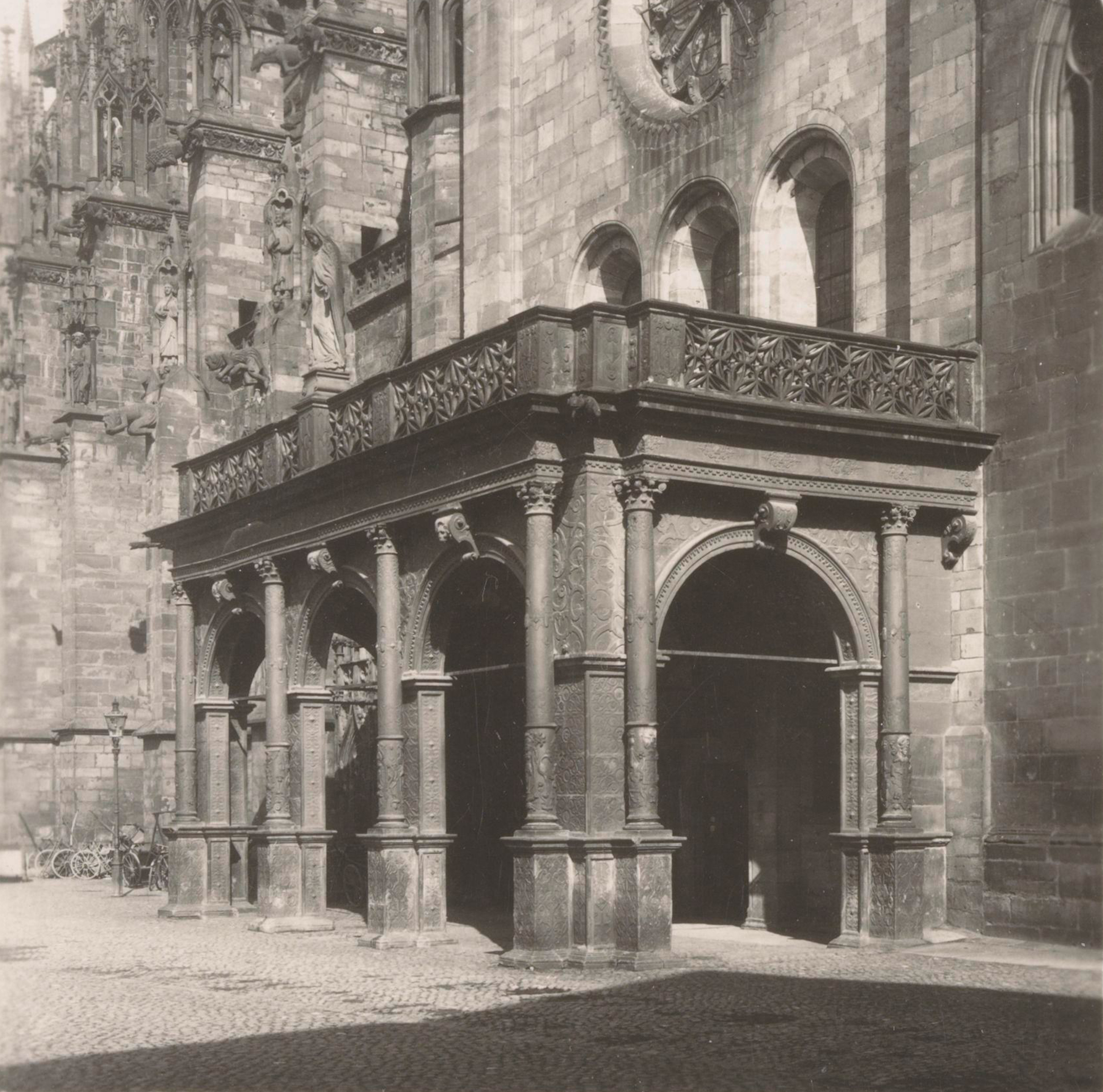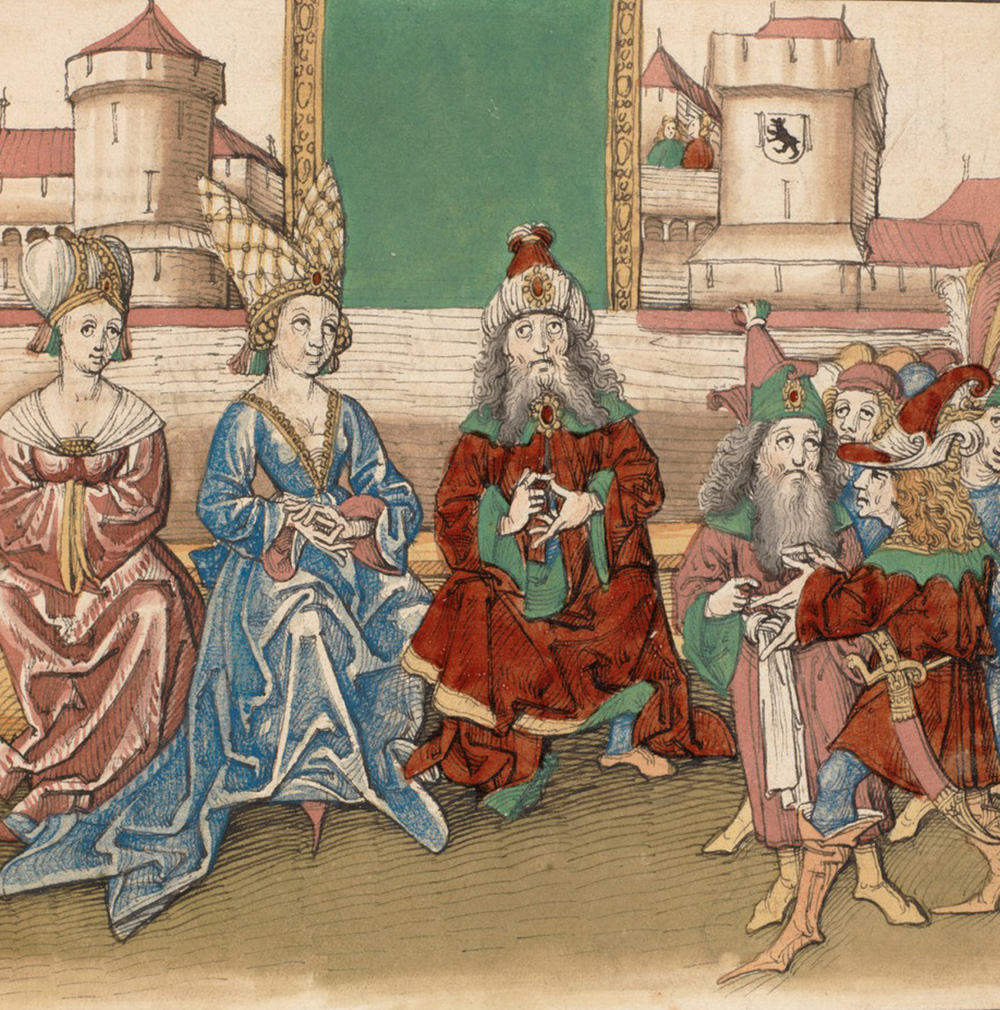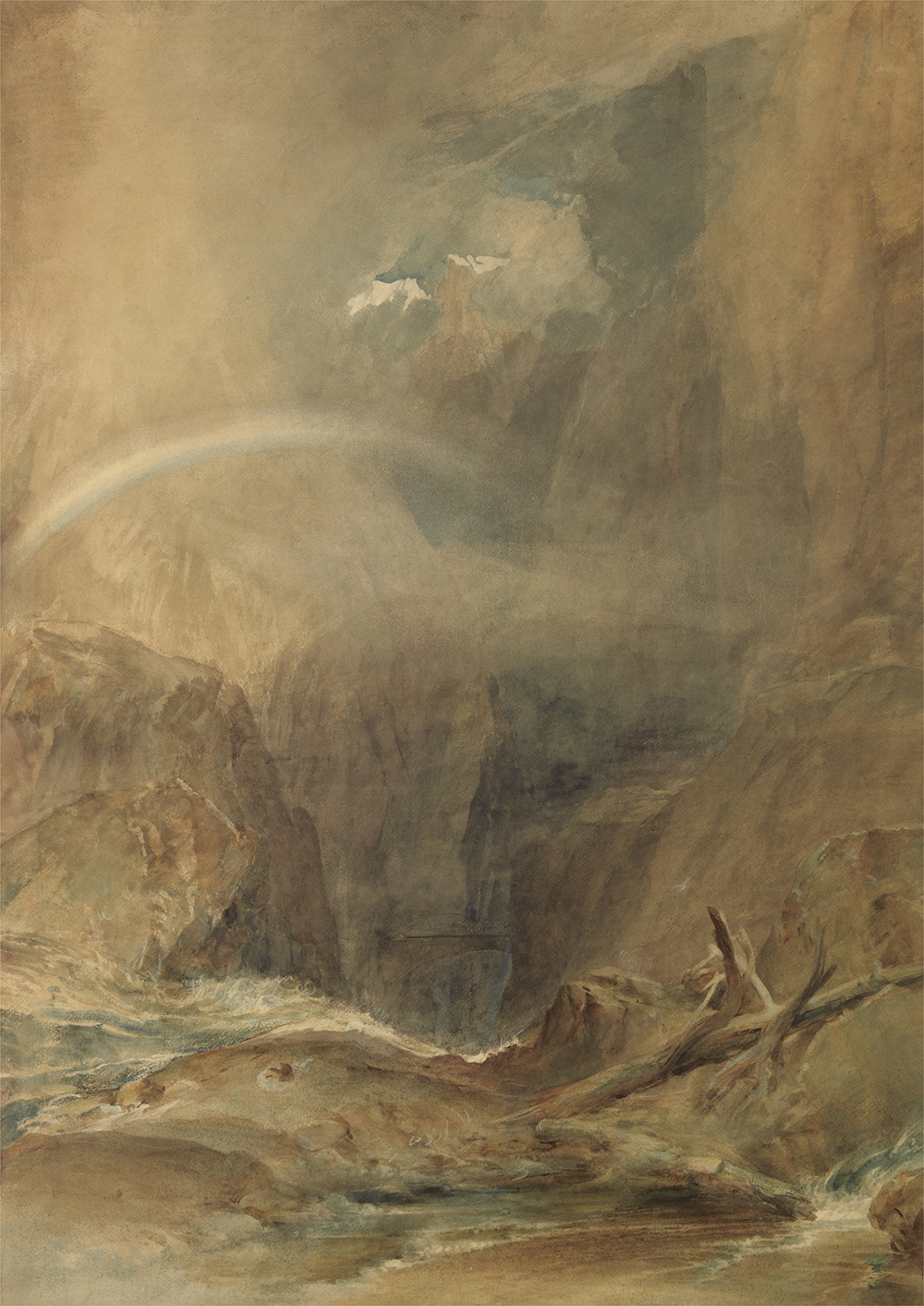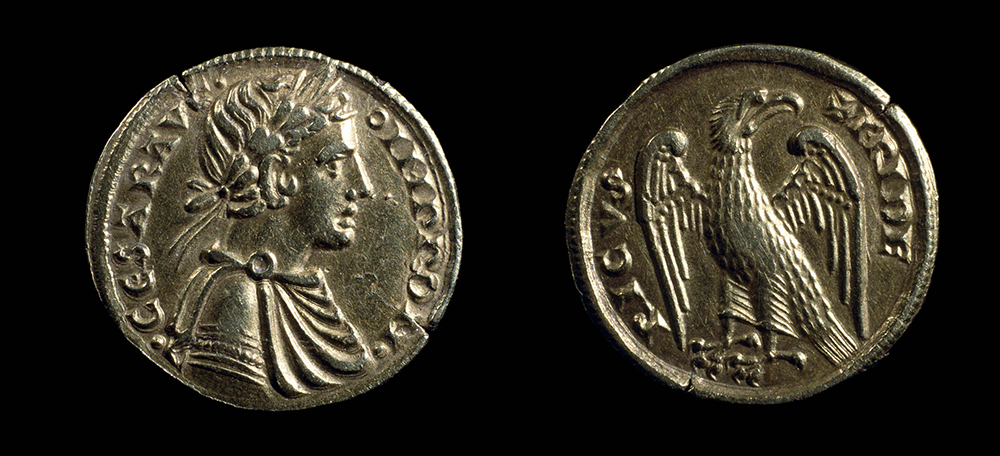
Entrance to Freiburg Minster, 1906. Photograph by Neue Photographische Gesellschaft A.G. Rijksmuseum.
In the High Middle Ages, an era that devotes itself to conjuring up vast churches and palaces and excels at great intellectual and religious movements, it is good to focus first on a couple of small objects. The first is really tiny—a spherical lattice about the size of a Christmas-tree ornament, made in one of the Meuse towns, perhaps Dinant. Made from chiseled brass, it was designed to burn incense. The orb is made up of stylized creatures and foliage, but the note of genius is that there are three tiny people on top, showing eloquent surprise at their situation. These are (in a tumble of charismatic names) Shadrach, Meshach, and Abednego, the Jewish men whose faith was tested in the fiery furnace by King Nebuchadnezzar. It seems sad that these tiny characters should be trapped in a museum case in Lille and unable to continue to carry out their witty, nine-century-old role of having perfumed smoke pour upward and round them. Perhaps somewhere in Lille there is a secret underground movement to liberate them and return them to their true function.
The other, only slightly larger object, that I have also kept coming back to just because it is so mysterious, lurks high on a pillar in Freiburg Minster. This must have once been part of a much larger decorative scheme, long since erased but with these figures kept as a reminder, or—more likely—just because they are so wonderful. The carving shows three human figures engaged with three massive, terrible-jawed animals, two of these wearing human clothing. An enormous ram’s head hovers in space, unrelated to the already confused action, and presumably part of a now missing piece of the frieze. Round the corner is a sadly worn—but fabulous—little fragment of Alexander the Great in a griffin-powered flying machine. I have returned to these monsters over the years, not least because of the strange way they echo the animal masks of the Kwakwaka’wakw of the American northwest. I don’t say this as some borderline insane piece of ethnographic showing-off, but because my wife’s family live on the edge of the Salish Sea and most summers I rush off at the first chance to admire examples of this great artistic tradition. The Freiburg monsters also appear strangely Disney—the humans unperturbed by them, despite the way the sculptor has given them a terrible sense of muscular power. I had assumed they were just mysterious grotesques, but this turned out merely to be my own ignorance. When last in Freiburg somewhat to my dismay I was cheerfully informed by an official that the figure on the right, seemingly a woman on a monster, was in fact Samson (the long hair for strength) subduing a lion, while the two cowled men with the two clothed monsters were telling two different “frames” from the story of Wolf Inngrim, in which a monk dresses a wolf up in human clothes and tries to educate him (there is a little book and pen) but he keeps being distracted by a nearby sheep. Unable to deny his wolfish nature, he turns from the monk and leaps on the sheep. A bit upset at this overturning of what I had lazily assumed was an ancient mystery, I quickly realized that it made no difference—these were creatures that conveyed brilliantly a universal human dismay and fascination.

The wolves were carved around 1200 in the opening phase of the building of Freiburg Minster. It was sponsored by Duke Berthold V, the last of the Zähringer dynasty, fresh from what would prove the equally lasting triumph of founding the city of Bern. These sorts of initiatives are characteristic of what was in many ways one of the most exciting, cheerful, and entertaining periods in all European history. As usual we could tut-tut about life expectancy, poor hygiene, and the relentless grind of agricultural labor, but this is just to buy into the patronizing and intellectually null idea that, in effect, the entire prior sum of human activity across the planet should be pitied and disregarded for not having had access to broadband.
The founding of Bern is a fine example of medieval mobility and ambition that, so close to old Roman cities such as Basel or Constance, could both build on earlier traditions and also start afresh. In 1191, Berthold ordered the clearing of a forested plateau, a previously unnoticed, brilliantly defendable peninsula looped by the River Aare. A series of highly unreliable but charming paintings in Bern, made many years later, show the discovery, the dense mass of trees and the climax—the killing of the bear which would become the heraldic symbol of Bern and would lead to many generations of unhappy animals living in the bear pits. With Berthold’s death in 1218, the already thriving settlement was able to negotiate with the emperor to become a Free Imperial City. Future generations of the Valois and Habsburg families would thoroughly regret this sequence of events, as well as another key breakthrough of the same decades: the opening up of the Saint Gotthard Pass.
Although the pass remained hair-raising for centuries (with a completely chilling bridge at one point, teetering over a chasm), horses could now travel from northern Europe to Bern to Italy—carrying either soldiers or merchants, but with a certain percentage adding themselves each year to the wind-dried piles already heaped down various gulches. While this would lead in due course to Bern’s wealth from long-distance trade, it also released into the wider world the tough, highly self-reliant, and until then mercifully shut-in mountain men of Uri, Schwyz, and Unterwalden, who would form the nucleus of the future Switzerland. The sense of the Swiss as relentlessly capable, implacable, and sitting in a sort of ice fortress has been appropriated by what is now the country’s “northern rim”: cheery commercial cities such as Basel, Schaffhausen, Zurich, and indeed Bern, southern bits of the Holy Roman Empire, at best sited on steep slopes. It was the genuinely inaccessible Uri, Schwyz, and Unterwalden (the original three Forest Cantons) which really began the trouble as trade, men, and concepts now fed up and down through Lucerne and along the Saint Gotthard. There is no way to pinpoint why too precisely, but unlike other regional protection associations which formed across the empire, the Swiss one became serious and permanent. The murals of tough guys that festoon the walls of places like the Basel town hall were not on the whole the sort of softies who actually lived in that town. In later centuries, when the Habsburg family or the dukes of Burgundy unwittingly took their armies just a little too far south toward the Alps, they crossed a sort of Swiss trip wire. This activated the real giant, stone-muscled characters of few words who came down from the mountains and caused mayhem. This shift began in the thirteenth century and had endless repercussions, not least through breaking the duopoly of what had been just West Francia and East Francia. Forms of independence became possible in the Alps even if the imperial authorities responded to it by simply pretending the Swiss did not exist (the Habsburgs finally acknowledged them formally only in 1648).

Elsewhere in the empire there was further awkwardness for Habsburgs. At the same time as Bern was first being built, in a near featureless wilderness of mud, sand, frogs, and shifting rivers, an equally ghastly future adversary was coalescing as an enterprising group of fishermen built a dam on the River Amstel. If Bern became the controlling intelligence for messing up the Habsburgs in the south, Amsterdam formed its matching pair in the north, and it is odd that they were founded near simultaneously. Given the glutinous, marshy world from which it emerged, Amsterdam was sited in an area of little perceived worth or feudal structure and was ignored by its notional overlord in Utrecht. Its fortune came both from evermore elaborate management of sluices and from a bolt of religious good luck—a particularly absurd miracle involving fireproof blessed bread turned Amsterdam into a major religious site. It then brought together fishing, shipping, and soapmaking in a harshly industrial combination (in contrast to all the weedy tapestries, fine gloves, and folderol that fueled the posh southern Low Countries) and became extremely rich.
Somehow, somebody worked out that mixing a little pouch in herrings’ stomachs into the barrel in which the fish were packed both preserved them and made them much tastier. In a world of frightening seasonal lurches from plenty to dearth, barrels of herring were a sort of miracle. Amsterdamers also invented special robust ships so the fish could be gutted and packed at sea, the vessels bobbing up and down on the Dogger Bank, home to an effective infinity of herring. At the height of the bonanza 200 million herring a year were being caught.
That is enough about Amsterdam, except to say that its origins and interests always lay north and east and in the outer world—in Germany, the Baltic, the North, the New World, and the eastern spice islands. Its attitude towards the rest of the Netherlands was, from its own origins onward, always somewhat aloof. It was part of the County of Holland, but felt a limited affinity for points south. Events, particularly religious and particularly Habsburg, meant that, like Bern, Amsterdam would become an implacable and awful enemy to external interferers, but almost despite itself—and neither city was ever captured by all those who ground their teeth with rage at their very mention, until they both fell at the end of the eighteenth century.

The political chaos of the first half of the thirteenth century turned out to be a boon not just for Bern and Amsterdam but for many other individual princes and cities. Just as everyone should be grateful for King John’s total incompetence leading to Magna Carta, so the Emperor Frederick II’s reign waved goodbye to any chance that the empire might become like France, whose kings spent the century successfully making their realm much warmer and more pleasant by massacring heretics in the south and taking over Provence. Frederick was an attractive figure of extraordinary talent, but his interests became so focused on Italy and the Mediterranean that his German nobles were able to wring concessions that meant individual princes had ever more active, practical independence over their fiefs. While Frederick was off on the Sixth Crusade—negotiating personally in Arabic for renewed Christian access to Jerusalem—or writing a treatise on falconry in Palermo, where his court was based for many years, or being accused of being the Antichrist, he was not helping his German subjects much. There had always been uneasiness between nobles, city councils, and the emperor, but now the result was definitively to make the German lands into a sort of geopolitical rubble, a highly creative one, with each ruler sponsoring state‑of‑the-art palaces, castles, churches, and monasteries in the cheerful pattern that can still be seen today.
The century was marked by exciting news stories—such as the introduction of paper from the Arabic world, partly thanks to Frederick, and its rapid replacement of clumsy vellum. This would have an unfortunate archival effect because of paper’s easy destruction but was in every other way a boon, making written books much cheaper and more widespread. Excitement was caused too by the Mongol invasions of the 1240s, which would be catastrophic for Eastern Europe but which further west proved merely an exciting frisson when the invasions came to an end as mysteriously as they had begun, having spread the recipe for Chinese gunpowder, the vast implications of which were worked out over coming centuries. There were waves of religious innovation which would have as great an impact, albeit in a different sphere. The Dominicans, Franciscans, Minorites, and the institution of beguinage would in their different fields reshape Christianity, all trying to drain what Pope Alexander III had called “the stinking slurry of heresy.” There were Dominican geniuses such as Meister Eckhart and Thomas Aquinas and startling mystics such as Christine of Saint-Trond, in Brabant, a cowherd who could speak Latin and performed extraordinary feats, spinning like a dervish or clambering up church rafters or to the top of towers in a trance.
Excerpted from Lotharingia: A Personal History of Europe’s Lost Country by Simon Winder. Published by Farrar, Straus and Giroux April 23, 2019. Copyright © 2019 by Simon Winder. All rights reserved.
